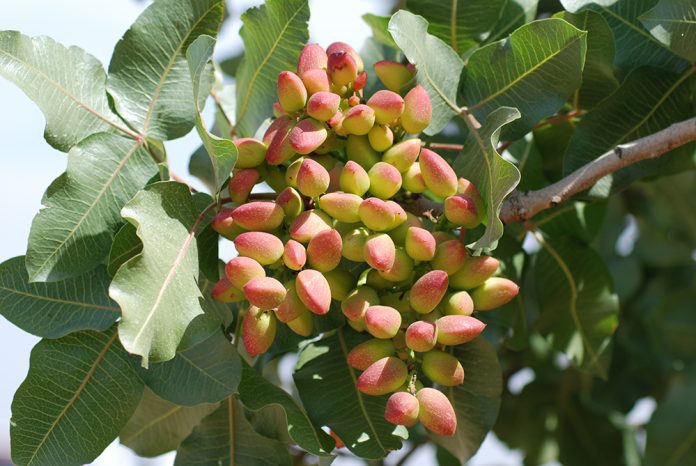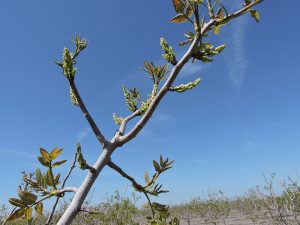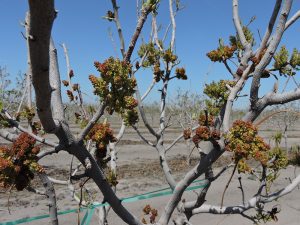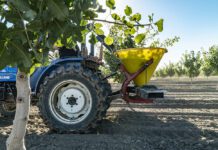
UC Westside, a new pollinizer for Kerman pistachios, has been released to help boost pistachio yields in low chill years, years that are becoming increasingly common in California pistachio production.
Released this spring, the pollinizer has high-quality pollen and a lot of it, according to Dan Parfitt, emeritus pomologist in the UC Davis Department of Plant Science. It is also precocious, flowering a year, and sometimes even two years ahead of Peters, the standard pollinizer for Kerman. And it flowers sooner in the season than Peters, helping ensure good pollination for Kerman in low-chill years.
“The intention with UC Westside was basically to provide another option for growers,” said Parfitt, who has been involved with the UC Pistachio Breeding Program since its start in 1990. “It is basically a supplement to Famoso, which is an earlier release that people used for Kerman, and also for our mid-season females.”
Famoso, which was released by the UC Breeding Program in 2016, has a more synchronous flowering period for Kerman than Peters in low-chill years, Parfitt said. “But in more moderate chill years, or more normal years, Famoso tends to be a little bit too early for Kerman, so UC Westside was brought out as a possible alternative.”

‘Just Not There’
The need for earlier flowering pollinizers for Kerman came to the forefront in 2014 and 2015, when low-chill years led to poor yield in orchards that were relying on Peters for pollination.
“We had low-chill winters, and the Peters just was not there when the Kerman female was ready,” said Louise Ferguson, UC Davis pomology specialist. “Peters was not showing up on some of the lower-chill years, and that was a problem.”
Peters, a large male that produces a lot of pollen, has performed well for many years, according to Parfitt. “Peters has been a good male over the years because it’s vigorous, it produces a lot of pollen, and it flowers over quite a long bloom period,” he said. “But over the last few years, it’s become more apparent that there’s an overlap bloom problem with Peters basically lagging Kerman several times.”
According to an article in the UCCE publication Kern Pistachio Notes, (C. Kallsen, Kern County Farm Advisor) Peters bloomed as much as 10 days behind Kerman in 2014 and 2015. “Additionally, many Peters inflorescences were nonfunctional, especially on the south side of trees, producing no viable pollen,” the June 2023 article stated.
Further, the article stated the flowering period of UC Westside has been coincident with Kerman in years with moderate to high chill. And in years of low chill, the cultivar has produced a dense bloom that overlaps the later bloom period of Kerman.
“For comparison, in trees of the same age and in the same location, UC Westside will be at full bloom five to seven days after the male pollinizer Randy,” the article stated.
Randy, a pollinizer developed for Golden Hills and released in 2005, also has been used as an early season pollinizer for Kerman, but, according to Parfitt, it generally is thought to be too early for Kerman.

Highly Synchronous
Famoso, released as an alternative to Peters in low-chill years, is highly synchronous with Kerman in very low chill years, according to the article. And like UC Westside, Famoso has a shorter juvenility period than Peters, producing flowers three to four years after budding. “However, in the increasingly infrequent high-chill years, the bloom period of Famoso may be too early to cover fully the latest bloom of Kerman,” the article stated.
Still, Famoso has a place in a Kerman orchard, UC researchers said, particularly when planted in combination with UC Westside.
The Kern Pistachio Notes noted that a 50-50 mix of UC Westside and Famoso in new Kerman commercial orchards “will provide a higher quantity of pollen and better bloom synchrony as the trees move from juvenility to maturity and under all foreseeable winter chilling scenarios in the Central Valley of California.”
The Pistachio Notes article further states that existing older Kerman orchards that are dependent solely on Peters for pollination would benefit by incorporating Famoso and UC Westside as additional pollinizers.
Ferguson, too, said that a combination of pollinators is desirable for Kerman orchards. “As the fogs decrease, and the winters become warmer, we want to make sure we hit the bloom of Kerman, because there is still a lot of Kerman acreage out there,” Ferguson said.
According to information from the UC Davis Foundation Plant Services, Famoso produces good quantities of viable pollen, and more closely matches the flowering dates of Kerman than Peters, especially when the Kerman bloom is extended. Bloom density is higher in Famoso than in Peters, the Foundation Plant Services states, and in low-chill years, Famoso has maintained better bloom synchrony with Kerman, especially in blocks that have been ‘oiled.’
Other Pollinizers
Other pollinizers available through the UC Pistachio Breeding Program include Tejon, an early flowering male pistachio released in 2016 that may be used as the principal pollinizer for the Gumdrop cultivar. “It has flowering synchrony with Gumdrop and produces good quantities of viable pollen,” according to information from Foundation Plant Services. “Tejon may be planted as an early flowering male in orchards of Golden Hills and Lost Hills to improve pollination in years with low winter chilling.”
Randy, according to Foundation Plant Services, may be used as a pollinizer for Golden Hills and Lost Hills. It has flowering synchrony with the two female cultivars, the information states, “and may be used to cover the earlier part of the Kerman flowering period during seasons in which Kerman flowering is extended,” an occurrence that generally happens during seasons of low chill. Randy was selected for high pollen viability, pollen durability and a high level of pollen production, and it flowers one to three weeks earlier than Peters.
As for UC Westside, Parfitt noted the cultivar’s budwood is now available and some licensed nurseries are growing it out.











